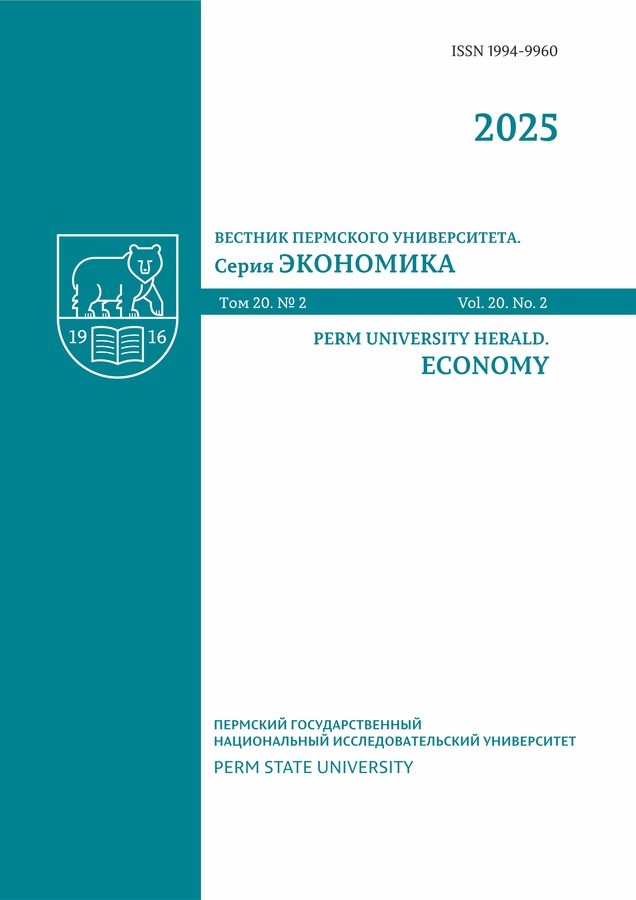On statistical modeling of random distribution of funds against various conditions
- Autores: Assaul V.N.1, Golovin A.V.2, Pogodin I.E.3
-
Afiliações:
- Saint Petersburg State University of Aerospace Instrumentation
- Saint Petersburg State University
- Naval Polytechnic Institute, The Military Education and Scientific Centre of the Navy “The Naval Academy named after Admiral of the Fleet of the Soviet Union N. G. Kuznetsov”
- Edição: Volume 20, Nº 2 (2025)
- Páginas: 119-130
- Seção: Mathematical, Statistical and Instrumental Methods in Economy
- URL: https://journal-vniispk.ru/1994-9960/article/view/351458
- DOI: https://doi.org/10.17072/1994-9960-2025-2-119-130
- EDN: https://elibrary.ru/MGWQNI
- ID: 351458
Citar
Texto integral
Resumo
Sobre autores
V. Assaul
Saint Petersburg State University of Aerospace Instrumentation
Email: vicvic21@yandex.ru
Código SPIN: 31093
Candidate of Sciences (Engineering), Associate Professor, Associate Professor at the Department of Applied Mathematics 67-A, Bolshaya Morskaya st., Saint Petersburg, 190000
A. Golovin
Saint Petersburg State University
Email: golovin50@mail.ru
Código SPIN: 41628
Scopus Author ID: 56962741400
Researcher ID: M-6118-2013
Candidate of Sciences (Physics and Mathematics), Senior Research Fellow, Faculty of Physics 1, Ulyanovskaya st., Saint Petersburg, 198504
I. Pogodin
Naval Polytechnic Institute, The Military Education and Scientific Centre of the Navy “The Naval Academy named after Admiral of the Fleet of the Soviet Union N. G. Kuznetsov”
Email: iepogodin@mail.ru
Código SPIN: 20075
Doctor of Sciences (Physics and Mathematics), Professor, Professor at the Department of Mathematics 15, Razvodnaya st., Peterhof, Saint Petersburg, 198510
Bibliografia
- Войнов И. В., Пудовкин С. Г., Телегин А. И. Моделирование экономических систем и процессов. Опыт моделирования ARIS-моделей. Челябинск: ЮУрГУ, 2002. 392 с. EDN SEBZXN
- Звягин Л. С. Практические приемы моделирования экономических систем // Проблемы современной экономики: материалы IV Междунар. науч. конф. Челябинск: Два комсомольца, 2015. С. 14–19. URL: https://clck.ru/3MZtEJ (дата обращения: 19.12.2024).
- Власов М. П., Шимко П. Д. Моделирование экономических процессов. Ростов н/Д: Феникс, 2005. 410 с. EDN VQMEWT
- Peters O., Gell-Mann M. Evaluating gambles using dynamics // Chaos. 2016. Vol. 26. Article 231003. doi: 10.1063/1.4940236
- Berman Y., Peters O., Adamou A. An empirical test of the ergodic hypothesis: Wealth distributions in the United States // SSRN. 13 Jun 2016. 40 p. doi: 10.2139/ssrn.2794830
- Peters O., Adamou A. The sum of log-normal variates in geometric Brownian motion // arXiv. 2018. 14 p. doi: 10.48550/arXiv.1802.02939
- Peters O., Adamou A. The time interpretation of expected utility theory // arXiv. 2018. 8 p. doi: 10.48550/arXiv.1801.03680
- Peters O. The ergodicity problem in economics // Nature Physics. 2019. Vol. 15. P. 1216–1221. doi: 10.1038/s41567-019-0732-0
- Meder D., Rabe F., Morville T., Madsen K. H., Koudahl M. T., Dolan R. J., Siebner H. R., Hulme O. J. Ergodicity-breaking reveals time optimal decision making in humans // arXiv. 2019. 43 p. doi: 10.48550/arXiv.1906.04652
- Bouchaut J. P., Mezard M. Wealth condensation in a simple model of economy // Physica A: Statistical Mechanics and its Applications. 2000. Vol. 282. P. 536–545. doi: 10.1016/S0378-4371(00)00205-3. EDN AFRCWN
- Frederic S., Loewenstein G., O’Donoghue T. Time discounting and time preference: A critical review // Journal of Economic Literature. 2002. Vol. 40, no. 2. P. 351–401. doi: 10.1257/jel.40.2.351. EDN EFMEPR
- Adamou A., Berman Y., Mavroyiannis D., Peters O. Microfoundations of discounting // arXiv. 2020. 28 p. doi: 10.48550/arXiv.1910.02137
- Adamou A., Peters O. Dynamics of inequality // Significance. 2016. Vol. 13, iss. 3. P. 32–35. doi: 10.1111/j.1740-9713.2016.00918.x
- Эксперимент: возникает ли финансовое неравенство при случайной раздаче денег // Хабр. Блог компании ITI Capital. Визуализация данных. 11.07.2017. URL: https://clck.ru/3MZtjE (дата обращения: 28.11.2024).
- Marsili M., Maslov S., Zhang Y. G. Dynamical optimization theory of a diversified portfolio // Physica A: Statistical Mechanics and its Applications. 1998. Vol. 253, iss. 1-4. P. 403–418. doi: 10.1016/S0378-4371(98)00075-2. EDN ORMMMX
- Peters O., Adamou A. Leverage efficiency // arXiv. 2011. 24 p. doi: 10.48550/arXiv.1101.4548
- Delvin K. The unfinished game: Pascal, Fermat, and the Seventeenth-Century Letter that Made the World Modern. Basic Books, 2010. 208 p.
- Montmort R. P. Essay d’analyse sur les jeux de hazard. American Mathematical Society, 2006. 414 p.
- Theil H. Economics and information. North-Holland Publ., 1967. 488 p.
- Кирьянов Д. В. Mathcad-15/Mathcad Prime 1.0. СПб.: БХВ-Петербург, 2012. 432 с.
Arquivos suplementares








